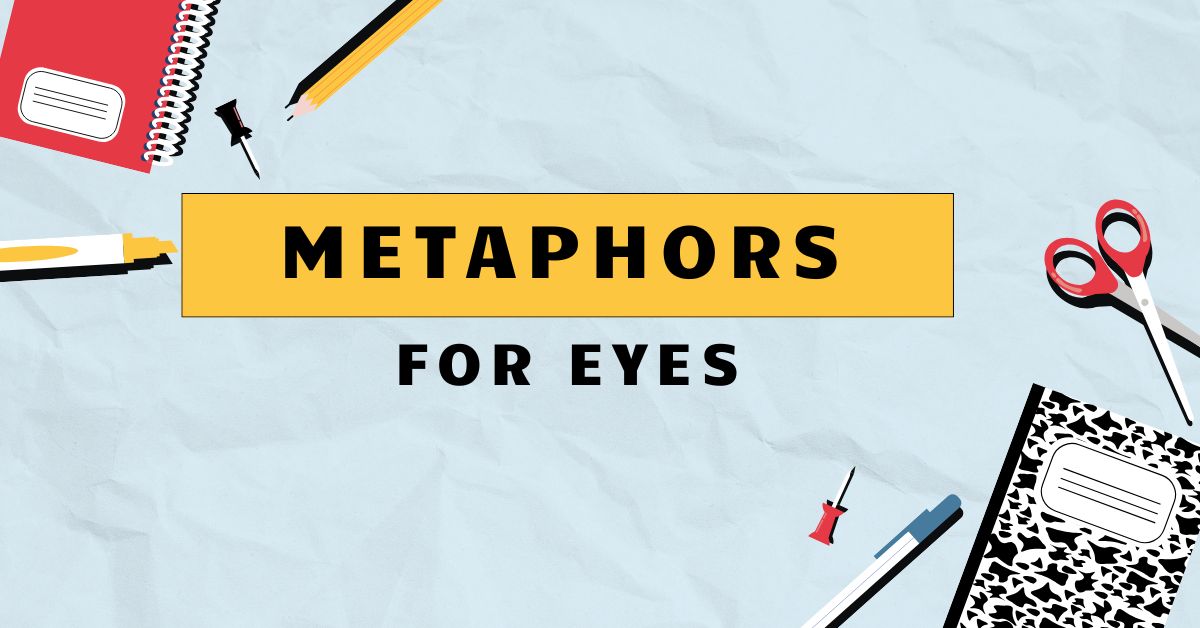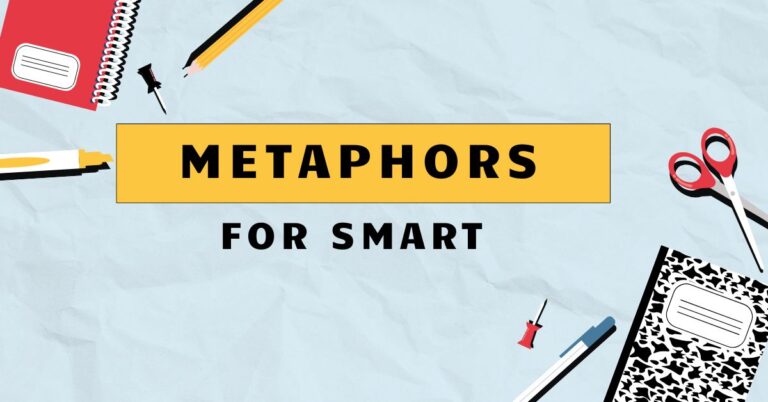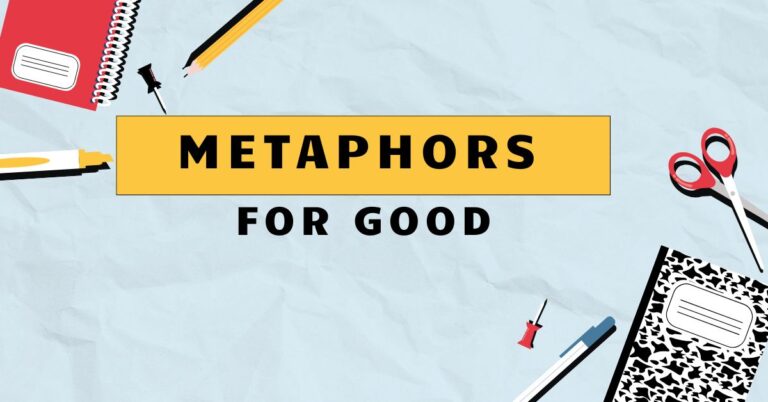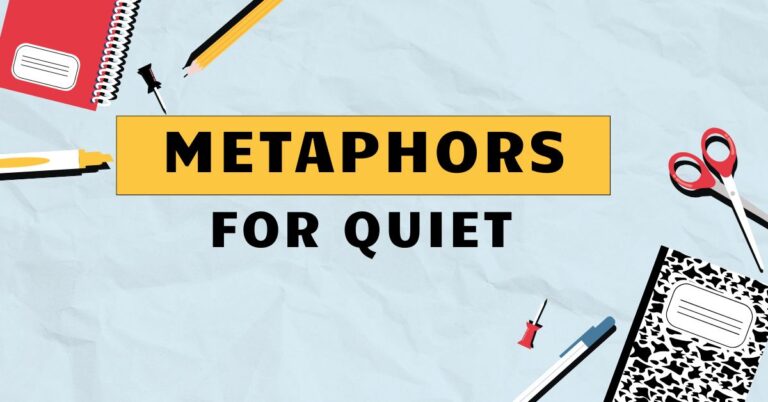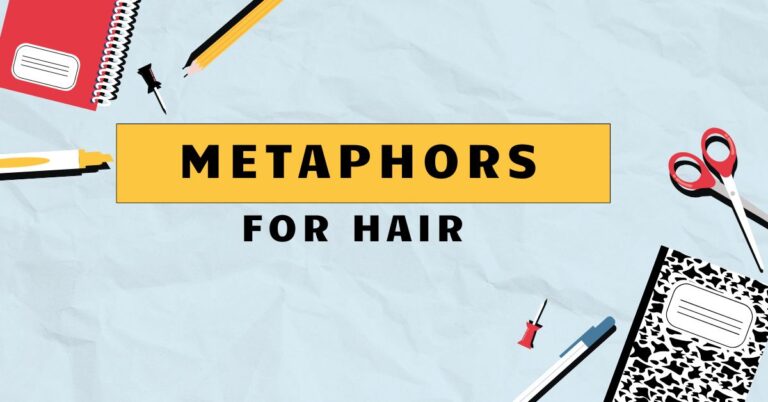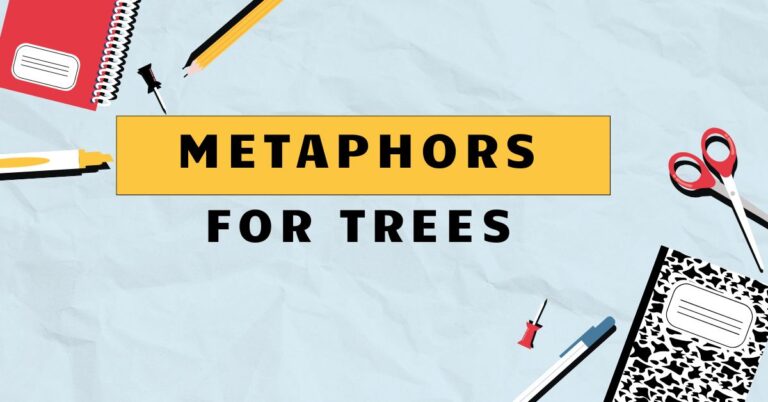43 Metaphors for Eyes: Understanding Figurative Language
Eyes, often described as the windows to the soul, are a frequent subject of figurative language. Understanding how metaphors are used to describe eyes enhances our comprehension and appreciation of literature, poetry, and everyday communication.
This article will explore the diverse ways eyes are metaphorically represented, providing a comprehensive guide for English language learners and enthusiasts alike. By examining various examples, usage rules, and common mistakes, this guide will equip you with the knowledge to effectively interpret and use metaphors for eyes.
Table of Contents
- Introduction
- Definition of Metaphor
- Eyes as a Metaphorical Subject
- Structural Breakdown
- Types of Metaphors for Eyes
- Examples of Metaphors for Eyes
- Usage Rules
- Common Mistakes
- Practice Exercises
- Advanced Topics
- FAQ
- Conclusion
Definition of Metaphor
A metaphor is a figure of speech that directly compares two unrelated things without using “like” or “as.” It asserts that one thing *is* another, creating a vivid and often surprising connection in the reader’s mind. Metaphors are essential for adding depth, color, and emotional resonance to language.
They allow writers and speakers to convey complex ideas in a concise and memorable way. Understanding metaphors is crucial for interpreting literature, poetry, and even everyday conversations.
The function of a metaphor extends beyond mere decoration. It serves to illuminate an aspect of the subject being described by associating it with something familiar or evocative.
This association can evoke emotions, create mental images, and deepen understanding. The context in which a metaphor is used significantly impacts its interpretation.
A metaphor that works well in one situation may be confusing or ineffective in another.
Eyes as a Metaphorical Subject
Eyes are a particularly rich subject for metaphorical expression. They are often considered the most expressive feature of the human face, capable of conveying a wide range of emotions and intentions.
Their color, shape, and movement provide ample material for metaphorical comparison. Furthermore, the cultural significance of eyes as symbols of perception, insight, and the soul makes them a potent source of figurative language.
Describing eyes through metaphor allows writers to evoke specific feelings and images in the reader’s mind.
The use of metaphors for eyes is prevalent across various forms of literature, from poetry and novels to drama and song lyrics. Authors use these metaphors to enhance character descriptions, set the mood, and deepen the emotional impact of their narratives.
The effectiveness of an eye metaphor hinges on its originality, clarity, and relevance to the overall context. A well-crafted metaphor can transform a simple description into a powerful and memorable image.
Structural Breakdown
The structure of a metaphor typically involves two key elements: thetenor(the subject being described) and thevehicle(the object or concept used for comparison). In the context of metaphors for eyes, the eyes are the tenor, and the various objects, colors, or concepts used to describe them are the vehicle.
The connection between the tenor and the vehicle creates the metaphorical meaning. Understanding this structure helps in analyzing and interpreting metaphors effectively.
For example, in the metaphor “her eyes were pools of sorrow,” the eyes are the tenor, and “pools of sorrow” is the vehicle. The comparison suggests that her eyes are deep, filled with emotion, and reflective, similar to pools of water.
The effectiveness of this metaphor lies in the reader’s ability to visualize the connection between the eyes and the image of sorrowful pools. The structural breakdown is shown in this table:
| Element | Description | Example |
|---|---|---|
| Tenor | The subject being described (eyes) | Her eyes |
| Vehicle | The object or concept used for comparison | Pools of sorrow |
| Connection | The link between the tenor and vehicle | Depth, emotion, reflectiveness |
The implied connection between the tenor and the vehicle is crucial. It bridges the gap between the literal and figurative meanings.
The stronger and more relevant the connection, the more effective the metaphor will be. Analyzing the structural elements helps to dissect the meaning and purpose of any metaphor.
Types of Metaphors for Eyes
Metaphors for eyes can be categorized based on the type of comparison being made. Common categories include color metaphors, object metaphors, emotional metaphors, animal metaphors, and light metaphors.
Each category offers a unique perspective on the qualities and characteristics of eyes.
Color Metaphors
Color metaphors describe the color of the eyes using different shades and hues. These metaphors can evoke specific moods and associations based on the cultural significance of the color.
For example, “sea-green eyes” might suggest calmness and depth, while “fiery-red eyes” could imply anger or intensity.
Object Metaphors
Object metaphors compare eyes to inanimate objects, focusing on their shape, size, or texture. Examples include “marble eyes” (implying coldness or impassivity) or “window eyes” (suggesting transparency and openness).
These metaphors create a visual image that enhances the reader’s understanding of the eyes’ appearance or character.
Emotional Metaphors
Emotional metaphors describe eyes in terms of the emotions they convey or reflect. These metaphors highlight the expressive power of the eyes and their ability to reveal inner feelings.
Examples include “eyes of sorrow” or “eyes of joy.” These metaphors deepen the emotional connection between the reader and the subject.
Animal Metaphors
Animal metaphors compare eyes to those of specific animals, drawing on the characteristics associated with those animals. For instance, “eagle eyes” might suggest sharpness and vigilance, while “doe eyes” could imply innocence and vulnerability.
These metaphors add a layer of animalistic imagery to the description of the eyes.
Light Metaphors
Light metaphors describe eyes in terms of light and illumination, focusing on their brightness, clarity, or intensity. Examples include “sparkling eyes” or “dull eyes.” These metaphors underscore the eyes’ ability to reflect light and convey vitality or lack thereof.
Examples of Metaphors for Eyes
The following sections provide extensive examples of metaphors for eyes, organized by category. Each example is designed to illustrate the specific type of comparison being made and its effect on the overall description.
These examples will help you understand how different types of metaphors can be used to describe eyes in a vivid and meaningful way.
Color-Based Metaphors
Color metaphors are a popular way to describe eyes, using shades and hues to evoke specific moods and associations. The following table provides a variety of color-based metaphors for eyes, along with their implied meanings.
| Metaphor | Implied Meaning |
|---|---|
| Her eyes were pools of sapphire. | Deep blue color, suggesting depth and calmness. |
| His eyes were emerald jewels. | Green color, suggesting rarity and preciousness. |
| Her eyes were amber flames. | Warm brown color, suggesting warmth and energy. |
| His eyes were icy glaciers. | Pale blue, suggesting coldness and detachment. |
| Her eyes were chocolate fountains. | Dark brown, suggesting richness and sweetness. |
| His eyes were golden honey. | Yellowish-brown, suggesting sweetness and warmth. |
| Her eyes were stormy grey skies. | Grey, suggesting sadness or impending trouble. |
| His eyes were violet twilight. | Purple, suggesting mystery and beauty. |
| Her eyes were oceanic turquoise. | Blue-green, suggesting vastness and tranquility. |
| His eyes were burnt sienna. | Reddish-brown, suggesting earthiness and warmth. |
| Her eyes were lavender fields. | Light purple, suggesting calmness and serenity. |
| His eyes were midnight indigo. | Dark blue, suggesting depth and mystery. |
| Her eyes were forest green. | Green, suggesting nature and growth. |
| His eyes were rusty copper. | Reddish-brown, suggesting age and history. |
| Her eyes were silver streams. | Light grey, suggesting fluidity and grace. |
| His eyes were bronze shields. | Metallic brown, suggesting protection and strength. |
| Her eyes were coral reefs. | Pinkish-red, suggesting vibrancy and life. |
| His eyes were obsidian mirrors. | Black, suggesting depth and reflection. |
| Her eyes were topaz gems. | Yellowish-brown, suggesting value and beauty. |
| His eyes were steel blue. | Greyish-blue, suggesting strength and determination. |
| Her eyes were aquamarine depths. | Pale blue-green, suggesting clarity and depth. |
| His eyes were crimson embers. | Deep red, suggesting fading passion or anger. |
| Her eyes were jade stones. | Green, suggesting serenity and good fortune. |
| His eyes were onyx beads. | Black, suggesting mystery and elegance. |
| Her eyes were rose quartz. | Pale pink, suggesting gentleness and love. |
Object-Based Metaphors
Object metaphors compare eyes to inanimate objects, focusing on their shape, size, or texture. These metaphors create a visual image that enhances the reader’s understanding of the eyes’ appearance or character.
The table below shows examples of this.
| Metaphor | Implied Meaning |
|---|---|
| Her eyes were shining beacons. | Bright and guiding, suggesting hope and direction. |
| His eyes were bottomless pits. | Deep and dark, suggesting mystery or despair. |
| Her eyes were mirrors of the soul. | Reflective and revealing, suggesting honesty and transparency. |
| His eyes were cold marbles. | Hard and unfeeling, suggesting detachment and indifference. |
| Her eyes were windows to the world. | Open and perceptive, suggesting curiosity and awareness. |
| His eyes were distant stars. | Faraway and unreachable, suggesting longing or sadness. |
| Her eyes were hidden chambers. | Secretive and mysterious, suggesting hidden depths. |
| His eyes were ancient maps. | Detailed and experienced, suggesting wisdom and history. |
| Her eyes were crystal balls. | Clear and insightful, suggesting foresight and intuition. |
| His eyes were iron gates. | Strong and unyielding, suggesting determination and resilience. |
| Her eyes were velvet curtains. | Soft and concealing, suggesting allure and mystery. |
| His eyes were stone walls. | Impenetrable and guarded, suggesting emotional distance. |
| Her eyes were glassy surfaces. | Fragile and reflective, suggesting vulnerability. |
| His eyes were silent pools. | Calm and reflective, suggesting introspection. |
| Her eyes were open books. | Easy to read and understand, suggesting honesty. |
| His eyes were hidden vaults. | Holding secrets, suggesting mystery and intrigue. |
| Her eyes were burning coals. | Intense and passionate, suggesting strong emotions. |
| His eyes were empty shells. | Hollow and devoid of emotion, suggesting loss. |
| Her eyes were spinning globes. | Full of wonder, suggesting curiosity and exploration. |
| His eyes were frozen lakes. | Cold and unmoving, suggesting emotional stagnation. |
| Her eyes were ancient coins. | Old and valuable, suggesting wisdom and experience. |
| His eyes were sealed letters. | Containing secrets, suggesting mystery and intrigue. |
| Her eyes were dancing flames. | Lively and energetic, suggesting passion and joy. |
| His eyes were buried treasures. | Hidden and precious, suggesting inner worth. |
| Her eyes were woven tapestries. | Complex and intricate, suggesting depth and richness. |
Emotion-Based Metaphors
Emotional metaphors describe eyes in terms of the emotions they convey or reflect. These metaphors highlight the expressive power of the eyes and their ability to reveal inner feelings.
The following table gives examples of this.
| Metaphor | Implied Meaning |
|---|---|
| Her eyes were wells of sadness. | Deeply sorrowful, suggesting overwhelming grief. |
| His eyes were harbors of peace. | Calm and soothing, suggesting tranquility and comfort. |
| Her eyes were fires of passion. | Intense and burning, suggesting strong desire and excitement. |
| His eyes were shadows of fear. | Haunted and anxious, suggesting deep-seated worry. |
| Her eyes were gardens of joy. | Bright and cheerful, suggesting happiness and delight. |
| His eyes were oceans of despair. | Vast and overwhelming, suggesting profound hopelessness. |
| Her eyes were sparks of mischief. | Playful and teasing, suggesting a lighthearted nature. |
| His eyes were storms of anger. | Violent and uncontrolled, suggesting intense rage. |
| Her eyes were pools of serenity. | Calm and peaceful, suggesting inner harmony. |
| His eyes were mirrors of doubt. | Reflecting uncertainty, suggesting skepticism. |
| Her eyes were fountains of hope. | Overflowing with optimism, suggesting unwavering belief. |
| His eyes were deserts of loneliness. | Empty and barren, suggesting isolation. |
| Her eyes were glimmers of excitement. | Showing anticipation, suggesting eagerness. |
| His eyes were depths of sorrow. | Profoundly sad, suggesting overwhelming grief. |
| Her eyes were beacons of love. | Shining with affection, suggesting deep care. |
| His eyes were glaciers of indifference. | Cold and unfeeling, suggesting apathy. |
| Her eyes were bursts of laughter. | Full of mirth, suggesting joy and amusement. |
| His eyes were whispers of anxiety. | Showing nervousness, suggesting unease. |
| Her eyes were havens of trust. | Safe and reliable, suggesting confidence. |
| His eyes were voids of empathy. | Lacking compassion, suggesting insensitivity. |
| Her eyes were flames of defiance. | Showing resistance, suggesting rebellion. |
| His eyes were shores of comfort. | Providing solace, suggesting reassurance. |
| Her eyes were springs of delight. | Bubbling with joy, suggesting happiness. |
| His eyes were abysses of despair. | Deeply hopeless, suggesting profound sadness. |
| Her eyes were embers of nostalgia. | Glowing with memories, suggesting longing for the past. |
Animal-Based Metaphors
Animal metaphors compare eyes to those of specific animals, drawing on the characteristics associated with those animals. This adds a layer of imagery and can quickly convey a sense of the person’s nature or demeanor.
The following table gives examples.
| Metaphor | Implied Meaning |
|---|---|
| Her eyes were eagle eyes. | Sharp and keen, suggesting vigilance and precision. |
| His eyes were doe eyes. | Large and innocent, suggesting vulnerability and gentleness. |
| Her eyes were cat eyes. | Mysterious and alluring, suggesting cunning and independence. |
| His eyes were hawk eyes. | Observant and predatory, suggesting watchfulness. |
| Her eyes were owl eyes. | Wise and knowing, suggesting intelligence and perceptiveness. |
| His eyes were serpent eyes. | Cold and calculating, suggesting deceit and danger. |
| Her eyes were kitten eyes. | Playful and endearing, suggesting innocence and charm. |
| His eyes were wolf eyes. | Fierce and intense, suggesting aggression and dominance. |
| Her eyes were fish eyes. | Glassy and unblinking, suggesting detachment. |
| His eyes were lion eyes. | Courageous and regal, suggesting bravery and authority. |
| Her eyes were lamb eyes. | Gentle and meek, suggesting innocence and purity. |
| His eyes were fox eyes. | Sly and cunning, suggesting intelligence and trickery. |
| Her eyes were bird eyes. | Bright and alert, suggesting inquisitiveness and freedom. |
| His eyes were rat eyes. | Shifty and suspicious, suggesting untrustworthiness. |
| Her eyes were turtle eyes. | Slow and steady, suggesting wisdom and patience. |
| His eyes were bear eyes. | Strong and protective, suggesting power and comfort. |
| Her eyes were butterfly eyes. | Delicate and beautiful, suggesting grace and transformation. |
| His eyes were shark eyes. | Relentless and predatory, suggesting determination. |
| Her eyes were pigeon eyes. | Innocent and unassuming, suggesting simplicity. |
| His eyes were tiger eyes. | Striking and intense, suggesting power and danger. |
| Her eyes were peacock eyes. | Bright and showy, suggesting pride and beauty. |
| His eyes were crocodile eyes. | Deceptive and patient, suggesting hidden danger. |
| Her eyes were swan eyes. | Elegant and graceful, suggesting beauty and poise. |
| His eyes were bull eyes. | Strong and unwavering, suggesting determination and power. |
| Her eyes were canary eyes. | Bright and cheerful, suggesting happiness and vitality. |
Light-Based Metaphors
Light metaphors describe eyes in terms of light and illumination, focusing on their brightness, clarity, or intensity. These metaphors often underscore the eyes’ ability to reflect light and convey vitality or a lack thereof.
Here is a table of examples.
| Metaphor | Implied Meaning |
|---|---|
| Her eyes were sparkling stars. | Bright and twinkling, suggesting happiness and energy. |
| His eyes were dull embers. | Dim and fading, suggesting sadness or exhaustion. |
| Her eyes were radiant beacons. | Shining brightly, suggesting hope and guidance. |
| His eyes were flickering candles. | Unsteady and weak, suggesting vulnerability. |
| Her eyes were glowing lanterns. | Warm and inviting, suggesting comfort and security. |
| His eyes were shadowed moons. | Dim and mysterious, suggesting hidden depths. |
| Her eyes were brilliant suns. | Bright and powerful, suggesting vitality and strength. |
| His eyes were dimming lights. | Fading and weak, suggesting decline. |
| Her eyes were twinkling fireflies. | Playful and fleeting, suggesting joy and charm. |
| His eyes were smoldering coals. | Burning slowly, suggesting suppressed anger. |
| Her eyes were shimmering glimmers. | Subtle and captivating, suggesting allure. |
| His eyes were black holes. | Devoid of light, suggesting emptiness. |
| Her eyes were luminous pearls. | Shining softly, suggesting beauty and purity. |
| His eyes were muted glows. | Subdued and gentle, suggesting calmness. |
| Her eyes were dancing flames. | Lively and energetic, suggesting passion. |
| His eyes were extinguished stars. | Lifeless and dark, suggesting loss. |
| Her eyes were blazing torches. | Intense and illuminating, suggesting fervor. |
| His eyes were veiled shadows. | Concealed and mysterious, suggesting secrets. |
| Her eyes were iridescent rainbows. | Colorful and radiant, suggesting joy. |
| His eyes were waning moons. | Fading and weak, suggesting decline. |
| Her eyes were haloed glows. | Bright and ethereal, suggesting purity and grace. |
| His eyes were obscured embers. | Hidden and fading, suggesting suppressed emotions. |
| Her eyes were effulgent beams. | Radiant and brilliant, suggesting vitality and hope. |
| His eyes were obscured lanterns. | Dim and hidden, suggesting mystery and secrets. |
| Her eyes were incandescent flares. | Bright and intense, suggesting passion and energy. |
Usage Rules
Using metaphors effectively requires careful consideration of context, clarity, and originality. The primary rule is to ensure that the comparison between the tenor (eyes) and the vehicle (the object or concept used for comparison) is both meaningful and understandable.
Avoid clichés and strive for fresh, imaginative comparisons that will resonate with the reader. A poorly chosen metaphor can confuse or distract from the intended meaning.
Another important rule is to maintain consistency within the metaphor. Once you have established a metaphorical comparison, avoid introducing conflicting or contradictory images.
For example, if you describe eyes as “pools of sadness,” avoid then describing them as “bursts of laughter.” Maintaining consistency enhances the impact and credibility of the metaphor.
Consider the cultural associations of the vehicle you choose. Some objects or concepts may have different meanings or connotations in different cultures.
Be mindful of these differences to avoid unintended interpretations or misunderstandings. A metaphor that works well in one cultural context may not be effective or appropriate in another.
The table below summarises the usage rules:
| Rule | Description |
|---|---|
| Meaningful Comparison | Ensure the comparison between eyes and the vehicle is logical and understandable. |
| Avoid Clichés | Strive for fresh, original metaphors rather than overused expressions. |
| Maintain Consistency | Avoid conflicting or contradictory images within the same metaphor. |
| Consider Cultural Associations | Be mindful of cultural differences in the interpretation of metaphors. |
Common Mistakes
One common mistake is using mixed metaphors, which occur when two or more inconsistent metaphors are combined. For example, saying “her eyes were a sea of sadness, but they also sparked like a wildfire” creates a confusing and contradictory image.
The sea and wildfire metaphors do not logically connect, resulting in a disjointed and ineffective description.
Another common mistake is using clichés or overused metaphors. While familiar metaphors can be easily understood, they lack originality and impact.
Phrases like “eyes like stars” or “windows to the soul” have been used so frequently that they have lost their power to evoke a strong emotional response. Strive for fresh and imaginative comparisons to capture the reader’s attention.
A further mistake is using metaphors that are too abstract or obscure. The comparison between the eyes and the vehicle should be clear and readily apparent.
If the reader has to struggle to understand the connection, the metaphor will likely fail to achieve its intended effect. Choose vehicles that are accessible and relevant to the reader’s experience.
Here’s a table illustrating common mistakes with corrections:
| Mistake | Incorrect Example | Corrected Example |
|---|---|---|
| Mixed Metaphor | Her eyes were a sea of sadness, but they also sparked like a wildfire. | Her eyes were a sea of sadness, deep and unending. |
| Cliché | Her eyes were like stars. | Her eyes twinkled like distant galaxies. |
| Abstract Metaphor | His eyes were quantum entanglement. | His eyes held a mysterious connection, as if linked by an invisible thread. |
Practice Exercises
These exercises will help you practice identifying and using metaphors for eyes. Read each sentence and identify the metaphor used to describe the eyes.
Then, rewrite the sentence using a different metaphor from the categories discussed.
Exercise 1: Identifying Metaphors
| Question | Answer |
|---|---|
| 1. Her eyes were emerald pools, reflecting the forest canopy. | Metaphor: Emerald pools. |
| 2. His eyes were cold marbles, unyielding and distant. | Metaphor: Cold marbles. |
| 3. Her eyes were wells of sorrow, overflowing with unspoken grief. | Metaphor: Wells of sorrow. |
| 4. His eyes were eagle eyes, sharp and ever watchful. | Metaphor: Eagle eyes. |
| 5. Her eyes were sparkling stars, twinkling with delight. | Metaphor: Sparkling stars. |
| 6. His eyes were distant stars, reflecting a faraway dream. | Metaphor: Distant stars. |
| 7. Her eyes were velvet curtains, hiding secrets deep within. | Metaphor: Velvet curtains. |
| 8. His eyes were stormy skies, threatening a downpour of emotions. | Metaphor: Stormy skies. |
| 9. Her eyes were shining beacons, guiding him through the darkness. | Metaphor: Shining beacons. |
| 10. His eyes were bottomless pits, drawing her into their depths. | Metaphor: Bottomless pits. |
Exercise 2: Rewriting Sentences with Different Metaphors
| Question | Answer |
|---|---|
| 1. Her eyes were emerald pools, reflecting the forest canopy. (Color) | Her eyes were forest green, vibrant and alive. |
| 2. His eyes were cold marbles, unyielding and distant. (Object) | His eyes were iron gates, guarded and impenetrable. |
| 3. Her eyes were wells of sorrow, overflowing with unspoken grief. (Emotion) | Her eyes were oceans of despair, vast and overwhelming. |
| 4. His eyes were eagle eyes, sharp and ever watchful. (Animal) | His eyes were hawk eyes, observant and keen. |
| 5. Her eyes were sparkling stars, twinkling with delight. (Light) | Her eyes were radiant beacons, shining with joy. |
| 6. His eyes were distant stars, reflecting a faraway dream. (Object) | His eyes were ancient maps, leading to forgotten lands. |
| 7. Her eyes were velvet curtains, hiding secrets deep within. (Object) | Her eyes were hidden chambers, full of untold stories. |
| 8. His eyes were stormy skies, threatening a downpour of emotions. (Color) | His eyes were stormy grey skies, warning of impending sadness. |
| 9. Her eyes were shining beacons, guiding him through the darkness. (Light) | Her eyes were glowing lanterns, illuminating the path ahead. |
| 10. His eyes were bottomless pits, drawing her into their depths. (Emotion) | His eyes were voids of empathy, leaving her feeling lost and alone. |
Advanced Topics
For advanced
For advanced learners, exploring extended metaphors and symbolic uses of eye metaphors can provide deeper insights. An extended metaphor is a metaphor that is developed over several lines or even throughout an entire work.
This allows for a more complex and nuanced comparison, enriching the text with layers of meaning. For example, a poem might describe someone’s eyes as “windows” and then continue to develop this metaphor by describing what can be seen through these windows, how they are opened or closed, and what reflections they hold.
Symbolic uses of eye metaphors often draw on cultural and literary traditions. In many cultures, eyes are seen as symbols of knowledge, insight, and spiritual awakening.
Using eye metaphors in a symbolic way can add depth and resonance to your writing, connecting it to broader themes and ideas. For example, describing someone’s eyes as “seeing” even when they are physically blind can symbolize their inner vision or wisdom.
Another advanced topic is the use of synesthesia in eye metaphors. Synesthesia is a literary device that combines different senses, such as sight and sound, to create a more vivid and immersive experience for the reader.
For example, describing someone’s eyes as having a “melodic gaze” combines the sense of sight with the sense of hearing, creating a unique and memorable image.
FAQ
Conclusion
Metaphors for eyes offer a rich and versatile way to enhance your writing and deepen your understanding of language. By exploring the different types of metaphors, understanding usage rules, and avoiding common mistakes, you can effectively use these figurative expressions to create vivid and memorable images.
Whether you are writing poetry, fiction, or everyday prose, mastering the art of eye metaphors will undoubtedly elevate your communication skills and enrich your appreciation of the English language.

